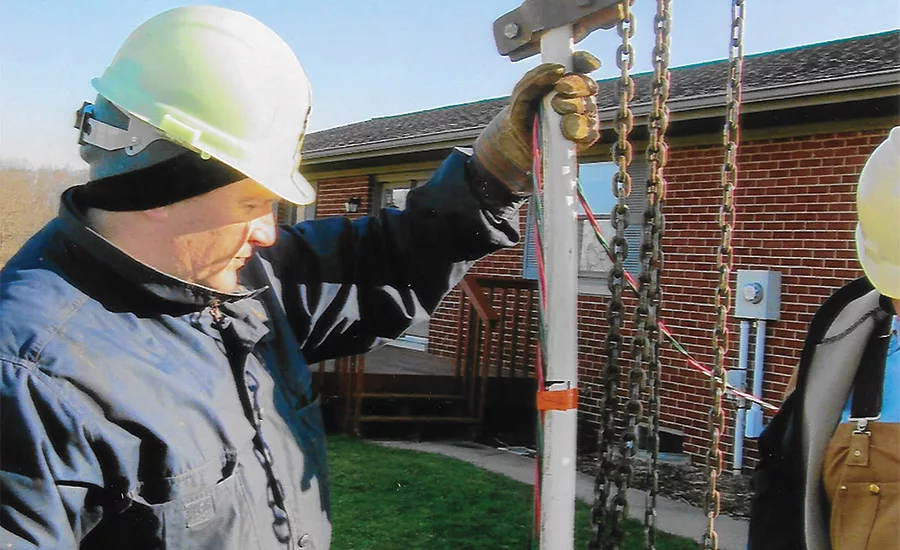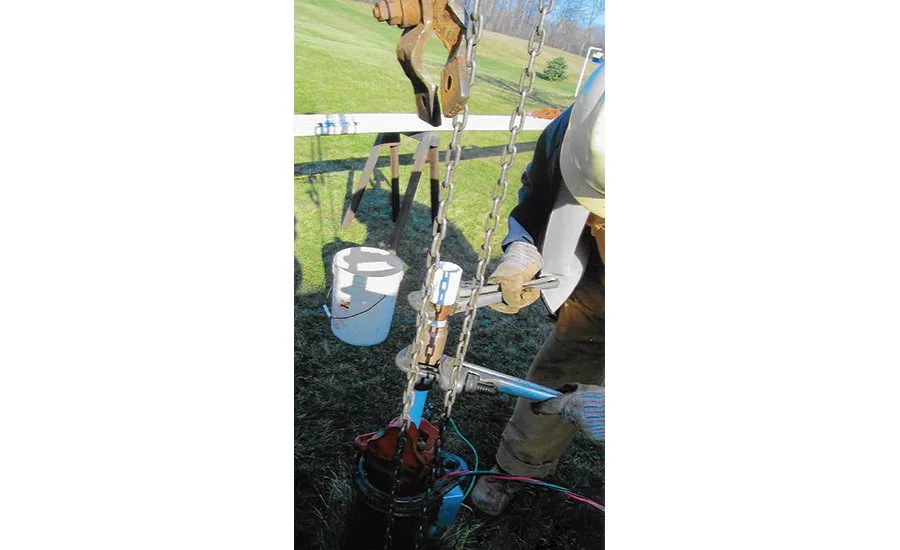How Drillers Can Make a Homemade Drill Pipe Pulling Tool

This pipe-pulling tool has improved and evolved over time, but it’s not far off from the original columnist John Schmitt’s father created in the 1930s. Here, it’s attached to a chain hoist using the A-frame of a small tractor as the lift point.
Source: John Schmitt photos

The two sides of Schmitt’s homemade pipe-pulling tool hang in an open position near the top of this photo. The tool encircles drop pipe and hangs on to it as it gets hoisted.
Several months ago, one of my readers sent me an email asking about the details of a pipe-pulling device I used to replace a pump in December 2015. I was busy writing about water conditioners and filters, but never intended to ignore the request of the reader (whose name, I believe, was Fred).
I had written about the pulling project some months after the actual job. Several colleagues have asked me since if I have pulled any lately the old-fashioned way — by hand. The answer is “no,” but I can share some details about the tool that actually grabbed the drop pipe to pull it from the well.
In this particular case, my helper — who happened to be my son-in-law — and I were pulling a pump from a 6-inch steel-cased well completed in a coarse sand and gravel formation to a depth of 179 feet. The static level in this well is about 80 feet (+/-) and the well has a terrific capacity. Therefore, the 25 gpm service pump had been set at 105 feet on schedule 80 PVC pipe of 1.25-inch size. We used the A-frame on a small tractor as a lift point. We were actually hooking the pipe, or grabbing it as some might say, with a tool made by my father in perhaps the 1930s. I remember working with my father as far back as early 1941 (before the USA entered World War II), and he always had this tool on his truck.
He made the tool from half-inch-thick steel that is two-inches wide. The total length is about 18 inches. Near one end, he had heated and bent the steel three times to form a V that goes around the pipe being pulled. A much shorter piece of similar steel was also bent in a V to match the one on the main part. Two ½-inch bolts connect these two parts to, in effect, encircle the pipe and grab onto it. While we were pulling PVC that day, he designed this tool to pull steel pipe (which was, of course, the drop pipe prior to the development of PVC or polyethylene). By adjusting the bolts that hold it together and using some bushings on these bolts, this tool can pull any pipe from 1 to 2 inches iron pipe size (IPS). We never did it, but the design could perhaps work for larger pipe.
The tool attaches to the pulling hook with a clevis (which, I believe, might also be used in agriculture). This clevis faces up and is attached to the tool itself with another ½-inch bolt. This bolt goes through the main body within an inch of the V sections. The device features a steel ring at the far end of the main section. This “trips” the tool, releasing its grip on the pipe being pulled. After some years of using this design, we added a small clevis closer to the V part. To that, we could attach a rope to pull the tool down if it was pulled up farther than we could reach.
I have used this tool with a rope block and tackle, with a chain hoist, and with a well rig and a pump hoist. In one case I recall, I used it on a rig with the lifting drum and had some resistance. Gravity would not bring the tool back to a reset point near the top of the casing, so we pulled it back to that point with ½-inch rope. I also used this rope to run the lifting tool up the pipe when running that pipe into the casing. We held the rope in the “trip” position until we wanted to grab the pipe, which it would do automatically.
This grabbing or lifting device is simplicity in itself, but had one dangerous feature. On the way back into the casing, if you let it contact the casing it would trip itself and drop the whole thing down the well. I don’t think this ever happened to us, but you had to beware at all times. On short pulls, we would tighten a pipe vise to the drop pipe a couple of inches below where the tool grabbed. We then had a fair chance of not dropping the pipe in the casing and having a serious fishing job. We also had to be careful not to let the trip rope catch on anything or accidentally pull it, or we would have the same disastrous results. If the drop pipe load was not too heavy one or two men could grab it with their hands, a third person could trip the grab, and the first two could slide the entire length of that section back down the casing. As I recall, in the December 2015 job my son-in-law was able to slide the first 60 feet of drop pipe into the well by this method. We stopped every 10 feet to tape the submersible cable to the drop pipe.
And that, readers, is the story of a really old tool that still works.
Next time, I’ll write about other lifting devices we used over the years as we got more modern equipment to do the job. Then I plan to write about the first drilling rig I ever had experience with — stories of this one will make you laugh or, perhaps, cry.
See more equipment stories
The weather in Michigan has been dry lately with some rather hot days and others that have been cool and pleasant. My infamous lawn is not growing very quickly and I now only have to mow every couple of weeks. If you have some old pipe-lifting devices or other drilling-related tools, I would be interested to hear about them. Until next time, work safe, do a good job and enjoy being a groundwater professional.
For more John Schmitt columns, visit www.thedriller.com/schmitt.
Looking for a reprint of this article?
From high-res PDFs to custom plaques, order your copy today!


